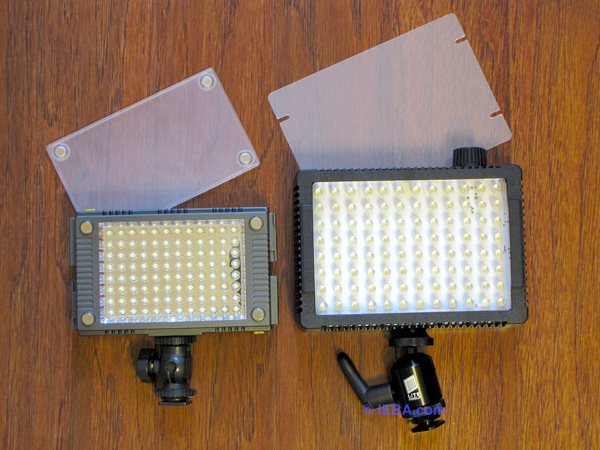Review: Litepanels MicroPro Hybrid DSLR LED
Litepanels recently shipped the MicroPro Hybrid, a dimmable, on-camera Hybrid LED that can refresh itself much faster than most any strobe light can. Thus it may pack a powerful 1-2 punch for DSLR producers who need to capture both video and still images. But how well does it handle both tasks? In this article Anthony Burokas reviews the new light and compares it to an LED light that's one-fifth the cost to see how these two lights measure up.
Comparison: Litepanels MicroPro vs. Sony Z96
For comparison, the Z96 is smaller and, with a Lithium-ion battery, considerably lighter than the MicroPro (Figure 7, below). The Z96's camera mount has much of the same capability as the Litepanels ball head, but the Z96's mount is easily 1/2 the size. The Z96 turns on without a distracting flash. The light is appealingly broad and the included diffusion filter widens it nicely. The two filters pop into place with near-zero effort and stay put perfectly. They come off easily as well. The hard plastic doesn't bend.

Figure 7. Front-side comparison of the Z96 (left) and MicroPro (right)
I have to admit that the magnetic filters have ended up to be much cooler and more useful than I could have ever guessed. There's the option to attach several Z96 lights together. The frame of the light is designed to connect, and some resellers offer the Z96 in 2"x2" packages or even bigger. This gives you a lot of light and it is a nice option to have when you need it.
The Z96 is not without its faults. When I use the Lithium-ion battery, the space for the AA's inside the light is just wasted space. It makes me wish for a light that has different powering modules and I could remove the AA and use the Lithium-ion, and the whole unit would be smaller.
The build quality is a bit wonky. My battery door won't open easily and, if there's no Lithium-ion battery in the outer part of the door, I have to use something else to pry the door open. So I added some tape as a "handle" to open the door. The LEDs aren't perfectly uniform so there may be some color temperature variation across the lot. But that's about it. I can live with both of those issues for 1/5 the cost of the MicroPro Hybrid. It doesn't "flash" for stills.
Conclusion
I had been dreaming of a single light that could conveniently work for both stills and video in this DSLR age. When properly set up, the MicroPro Hybrid does exactly what it's supposed to do: It flashes at a set brightness, and it flashes about as fast as I can take a picture. That means no more waiting for a camera strobe to recharge before I can take the next picture.
The core design of the MicroPro Hybrid works just like it should. However, the lack of communication between the camera and flash was a rude awakening from my dream. The camera has to manually be set for a good exposure at a certain distance, and that becomes the magic spot where the photos have to be taken. If that's OK for your workflow (corporate events, receptions, and the like), the MicroPro Hybrid is a great solution.
However I found several caveats: The LED beam spread is too narrow, and the lack of communication between the Hybrid and my camera wouldn't let me work how I wanted to work. The ball head can easily be replaced, and I can get used to the power switch location. But the Hybrid "popping" the flash when powering up, and the location of the flash sync port prevents storing filters on the back of the MicroPro, are both very annoying flaws that should have been avoided.
If these would not be issues for you, then the Litepanels MicroPro Hybrid is a great solution.